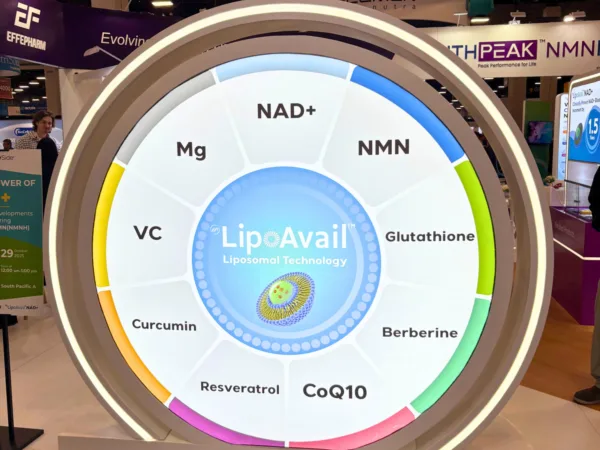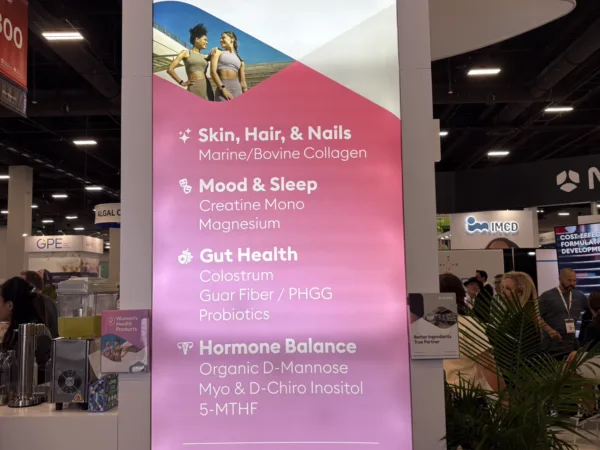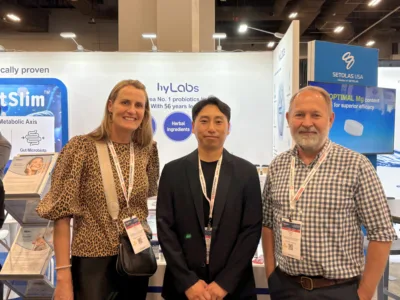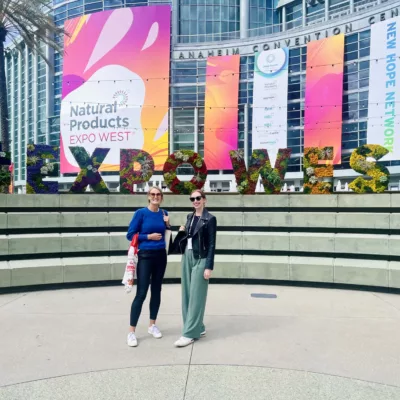The SupplySide Global 2025 event, held in October, highlighted how rapidly the global nutrition and supplement industries are evolving.
From GLP-1-focused formulations to advanced delivery systems and targeted women’s health innovations, the show reflected a decisive shift toward science-led, validated, and personalized solutions.
Below are the standout insights from Michael and Amanda based on their experience at the show.
#1: The GLP-1 Effect
The so-called “GLP-1 effect” was one of the dominant themes of the event.
As GLP-1 receptor agonists reshape eating behaviours and metabolic dynamics, supplement and functional food brands are responding with complementary nutrition strategies.
Ingredient manufacturers showcased targeted solutions, including products to support digestion, satiety, and muscle maintenance among GLP-1 users.
- Rousselot highlighted Nextida G, a specific collagen peptide composition for metabolic wellness and glucose control.
- Roquette presented its plant-based ingredient portfolio, aligning with demand for natural, functional solutions that complement metabolic therapies.
These developments show how ingredient innovation is bridging the gap between clinical pharmacology and functional nutrition, creating an entirely new category of GLP-1–compatible formulations that fits in with consumer needs.

#2: Berberine & the Bioavailability Challenge
Berberine, a bioactive compound found in some plants, may be useful in the treatment of a range of health issues including blood sugar regulation, cholesterol management and weight loss. It remains a high-interest metabolic health ingredient, but its historically low bioavailability continues to challenge product developers. At SSG 2025 there were several examples of increased berberine bioavailability through delivery system innovation.
This evolution underscores a broader market trend: reformulating established actives using next-generation delivery technologies to extend lifecycle value and improve efficacy claims.
#3: Creatine isn't just for Athletes!
Creatine was back in focus at SSG, but the positioning was markedly different to usual. Instead of just being marketed as a sports supplement, various companies were calling out its effectiveness in applications as wide-ranging as brain health, healthy ageing, women's health and general wellness.
Some key developments included:
- Diversified formats: Expansion into micronized, buffered, and HCl creatine forms to improve absorption and mixability.
- Market expansion: Women's health, seniors, and lifestyle consumers - beyond the athlete core.
- New applications: Growing research interest in brain health, bone integrity, and age-related muscle maintenance.
- Quality and compliance: Rising demand for traceability, certifications, and clean-label positioning within creatine supply chains.
This 'creatine comeback' illustrates how established ingredients are being refreshed through delivery optimisation and new scientific understandings.

#4: Liposomal Delivery Systems
Liposomal technology took centre stage at this year’s event, reinforcing its importance in improving ingredient stability and absorption in the nutraceutical category.
Exhibitors presented clinically supported liposomal formulations designed to improve bioavailability, stability, and targeted delivery of actives across multiple categories—particularly weight management, metabolic health, longevity, and skincare.
Key themes included:
- Advanced nutraceutical delivery: Liposomal Vitamin C, Glutathione, and NAD+/NMN precursors addressing traditional absorption barriers.
- Verification and quality control: A recurring discussion point was the need for structural validation— confirming products are truly liposomal and not simple emulsions through techniques such as electron cryomicroscopy.
#5: Women's Health Gets Specific
Women’s health innovation at SupplySide Global 2025 reflected a more granular, science-led approach, moving away from generic “for women” positioning toward life-stage-specific formulations.
Key areas of focus included:
- Menopause: Expanding demand for natural alternatives to HRT, with robust clinical validation.
- Reproductive and Maternal Health: Enhanced access to prenatal and fertility support nutrients.
- Healthy Aging: Solutions addressing bone, cognitive, and muscle health in older women.
- Botanicals: Shatavari emerged as a hero ingredient, with suppliers introducing standardized extracts targeting hormonal balance, stress resilience, and menopause symptom relief.
Suppliers are increasingly looking for science-backed actives and specificity to better meet women’s physiological needs across life stages, rather than just have a generic 'for women' approach.

What does it all mean?
Throughout the show there was one consistent message that stood out for Amanda and Michael:
Science and substantiation are now the foundation of commercial success.
Brands and formulators are prioritizing:
- Validated delivery systems.
- Ingredient synergy for multi-functional health outcomes. Combining ingredients for metabolic, cognitive, and performance benefits.
- Clinical and in-vitro evidence to support claims.
- Segmented, need-based product design (a stepping stone towards more personalised nutrition).
The convergence of nutraceuticals, functional foods, and pharmaceuticals is certainly accelerating!
We hope that this summary of our findings at SSG 25 got you excited and helps to inspire your innovation efforts in the coming months! If you would like more information about how we can help you formulate exciting new health and nutrition products, or would like to discuss our ingredient portfolio, please get in touch – we’d love to chat.




